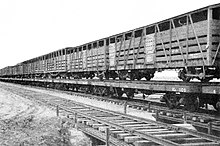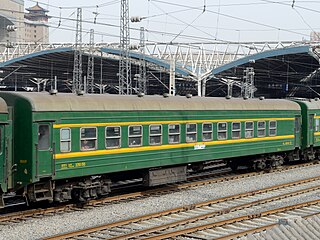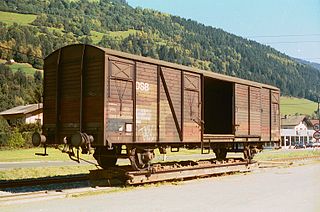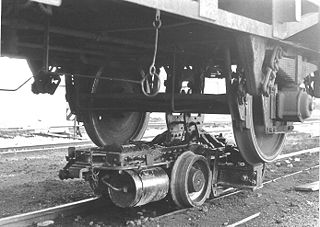
Piggyback transportation refers to the transportation of goods where one transportation unit is carried on the back of something else. It is a specialised form of intermodal transportation and combined transport. [1]

Piggyback transportation refers to the transportation of goods where one transportation unit is carried on the back of something else. It is a specialised form of intermodal transportation and combined transport. [1]
Piggyback is a corruption of pickaback, which is likely to be a folk etymology alteration of pick pack (1560s), which perhaps is from pick, a dialectal variant of the verb pitch. [2]

A person carrying someone else on their back is most commonly seen in the modern day in the form of a parent carrying an underage child, either for travelling or for children's games. It can involve the carrier crawling on hands and knees with the child straddling over the back like riding a horse, or with the carrier standing upright with the child hugging or cradled behind the back, often with the child's arms leaning over the carrier's shoulders and legs wrapping around the flanks.
Piggybacking may also feature in the context of play or sport, and evidence of this dates back to Ancient Greece where games involving piggyback riding were combined with the requirement of catching or throwing a ball. [3] In the modern era, wife carrying competitions, where the female participants ride on the back of their male partners running the race, are popular in some countries.


In rail transport, the practice of carrying trailers or semi-trailers in a train atop a flatcar is referred to as "piggybacking". [4] Early drawings of the Liverpool & Manchester Railway c1830 show road coaches being piggybacked on railway flat wagons. [5]
The rail service provided for trucks which are carried on trains for part of their journey is referred to as a rolling road, or rolling highway. A related transportation method is the rail transport of semi-trailers, without road tractors, sometimes referred to as "trailer on flatcar (TOFC)". In the United States, TOFC traffic grew from 1% of freight in 1957 to 5% in 1964 and 15% in 1986. [6] [7]
A railway wagon of one track gauge can be carried on a flat wagon (transporter wagon or rollbock) of another gauge. In addition, an entire train of coupled wagons of one gauge can be carried on continuous rails on a train of flat wagons of another gauge. This was achieved by the Commonwealth Railways on the Marree railway line in South Australia between Telford Cut and Port Augusta in the mid-1950s. [8] [9] Japan Railways planned a similar "Train on Train" scheme, but at much higher speeds, to operate from 2016. [10]
Small ships of all kinds can be piggybacked on larger ships. Examples include lifeboats, landing craft, and minesweepers on motherships, [11] as well as midget submarines on larger submarines, such as those used for the 1942 Japanese submarine attack on Sydney.
The 1930s British Short Mayo Composite, in which a smaller, four-engine floatplane aircraft named Mercury was carried aloft on the back of a larger four-engine flying boat named Maia, enabled the Mercury to achieve a greater range than would have been possible had it taken off under its own power. The American Space Shuttle was carried on top of specially-modified Boeing 747 Shuttle Carrier Aircraft when the shuttle landed at places other than Kennedy Space Center.
In space transportation systems, a smaller satellite that is carried as a secondary payload on a launch is said to be "piggybacked" on the main launch. It is often the case of small satellites and cubesats, since they can not usually afford accessing space on a dedicated launch and they choose instead to take profit of the remaining payload capacity in a big satellite launch. However, this is usually at the cost of not being able to fly to their desired orbit and having to remain on a similar orbit to that of the big satellite.
The metal caterpillar treads of a tank wear out quickly when travelling long distances on ordinary roads. Also, tracked vehicles seriously damage the tarmac layer of ordinary roads (unless the caterpillar treads are specially fitted with rubber pads to avoid this). It is therefore necessary to provide tank transporters, which have rubber tires, to the battlefield.

A railroad car, railcar, railway wagon, railway carriage, railway truck, railwagon, railcarriage or railtruck, also called a train car, train wagon, train carriage or train truck, is a vehicle used for the carrying of cargo or passengers on a rail transport network. Such cars, when coupled together and hauled by one or more locomotives, form a train. Alternatively, some passenger cars are self-propelled in which case they may be either single railcars or make up multiple units.

Intermodal freight transport involves the transportation of freight in an intermodal container or vehicle, using multiple modes of transportation, without any handling of the freight itself when changing modes. The method reduces cargo handling, and so improves security, reduces damage and loss, and allows freight to be transported faster. Reduced costs over road trucking is the key benefit for inter-continental use. This may be offset by reduced timings for road transport over shorter distances.

An autorack, also known as an auto carrier, is a specialized piece of railroad rolling stock used to transport automobiles and light trucks. Autoracks are used to transport new vehicles from factories to automotive distributors, and to transport passengers' vehicles in car shuttles and motorail services, such as Amtrak's Auto Train route.

A transporter wagon, in railway terminology, is a wagon (UIC) or railroad car (US) designed to carry other railway equipment. Normally, it is used to transport equipment of a different rail gauge. In most cases, a transporter wagon is a narrower gauge wagon for transporting a wider gauge equipment, allowing freight in a wider gauge wagons to reach destinations on the narrower gauge network without the expense and time of transshipment into a narrower gauge wagons.

A flatcar (US) is a piece of rolling stock that consists of an open, flat deck mounted on a pair of trucks (US) or bogies (UK), one at each end containing four or six wheels. Occasionally, flat cars designed to carry extra heavy or extra large loads are mounted on a pair of bogies under each end. The deck of the car can be wood or steel, and the sides of the deck can include pockets for stakes or tie-down points to secure loads. Flatcars designed for carrying machinery have sliding chain assemblies recessed in the deck.
A RoadRailer is a trailer or semi-trailer that can be hauled on roads by a tractor unit and then by way of a fifth wheel coupling, operate in a unit train on railway lines. The RoadRailer system allows trailers to be pulled by locomotives without the use of flatcars, instead attaching trailers directly to bogies.
TTX Company is a provider of railcars and related freight car management services to the North American rail industry. TTX's pool of railcars—over 168,000 cars and intermodal well cars—supports shippers in several industries where flatcars, boxcars and gondolas are required.

Rail freight transport is the use of railways and trains to transport cargo as opposed to human passengers.

Rollbocks, sometimes called transporter trailers, are narrow gauge railway trucks or bogies that allow a standard gauge wagon to 'piggyback' on a narrow-gauge line. The Vevey system enables a coupled train of standard gauge wagons to be automatically loaded or rolled onto Rollbocks, so that the train can then continue through a change of gauge.
The following outline is provided as an overview of and topical guide to transport:
Lorry-Rail is a rolling highway operator. Its mission consists of developing, promoting and marketing the new 1050 km rail-road service from Bettembourg, Luxembourg to le Boulou near Perpignan, France, for standard unaccompanied semi-trailers. It uses Modalohr piggyback wagons.

In rail transportation, a rolling highway or rolling road is a form of combined transport involving the conveying of road trucks by rail, referred to as Ro-La trains. The concept is a form of piggyback transportation.

Trailer on flatcar, also known as TOFC or piggyback, is the practice of carrying semi-trailers on railroad flatcars. TOFC allows for shippers to move truckloads long distances more cheaply than can be done by having each trailer towed by a truck, since one train can carry more than 100 trailers at once. The trailers will be moved by truck from their origin to an intermodal facility, where they will then be loaded onto a train, typically by a rubber tired gantry crane, for the bulk of their journey. Alternatively, trailers may be driven onto the flatcars via ramps by a terminal tractor. Near the destination, the trailers are unloaded at another facility and brought to their final destination by a tractor unit.

"Train on Train" is a concept for piggybacking by the trainload rather than one wagon at a time.
Keith Archibald Smith, OBE, AM, MIE Aust, FCIT, was an Australian engineer who was Chief Mechanical Engineer, and later Commissioner, for the Commonwealth Railways, which operates mostly in remote and desolate areas railways for the Federal Government.

A car shuttle train, or (sometimes) car-carrying train, is a shuttle train used to transport accompanied cars (automobiles), and usually also bicycles and other types of road vehicles, for a relatively short distance.

Cargobeamer is an intermodal transport system. It involves specially designed pallets which can be carried on a road trailer; the pallets are fitted on top of flatcars but can slide sideways to allow trucks to drive on and off smoothly at intermodal terminals. A first testing terminal was opened in Leipzig in Germany; trial runs between Leipzig and Lithuania were planned in November 2010. Since July 2021, the first full CargoBeamer terminal is available to the public transport market in Calais, France.
The Alpine rolling highway is a combined transport service, in the form of a rolling highway on special wagons traveling a distance of 175 km between France and Italy by the Mont Cenis Tunnel.
A pocket wagon is a freight wagon that has been specially designed for the transport of truck semi-trailers. This wagon belongs to the group of flat wagons in special design with bogies and is used in combined transport (CT). The name of these freight wagons comes from the fact that between the narrow longitudinal girders on the outside and also lengthways between the bogies, the so-called pockets are located, in which the wheels of the semi-trailers are particularly low. For flexible use in CT, pocket wagons have hinged latches with ISO spigots on the solebar, so that containers and swap bodies up to 45 ft can be accommodated. As a flat wagon, it bears the UIC generic letter S and, since it is intended for the transport of road vehicles on one level, the code letter d. Since it is also possible to transport containers in a pocket wagon, it bears the UIC generic mark Sdgs. In this context, the code letter g stands for "containers up to 60 feet" and the lower case s for the permitted speed of up to 100 km/h (62 mph). The wagons have a yellow triangle with a black P on the long side. The first pocket wagons were built in Germany as early as 1972 and further developed according to requirements.